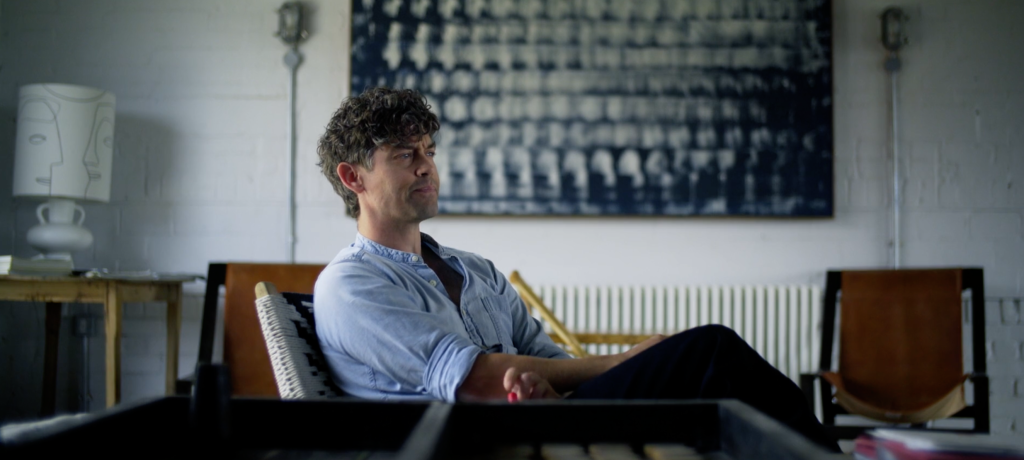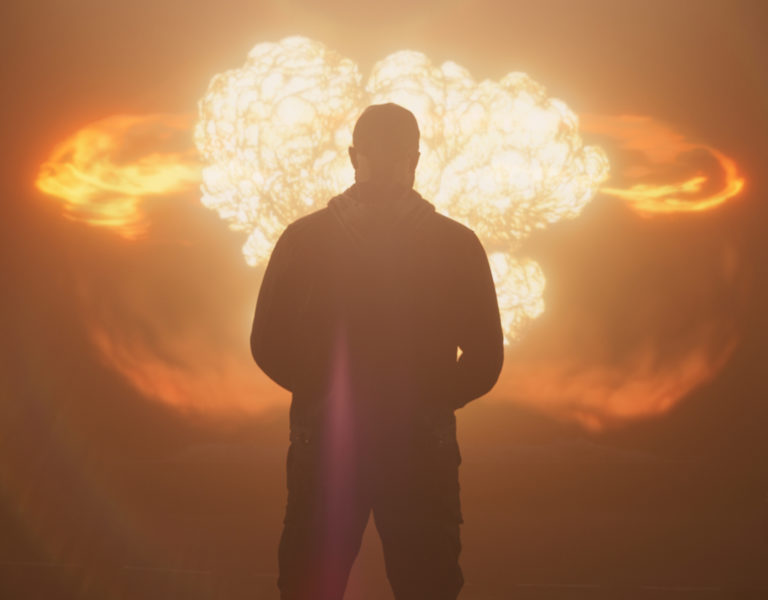The grape and the good
A swanky Sussex vineyard becomes the blood-spattered setting for Mark A. C. Brown’s comic thriller, Dead on the Vine – a pandemic project for first-time feature cinematographer Kieran Coyle. But Coyle is no stranger to life behind the lens, thanks to his 25 years spent as an award-winning news cameraman preparing him for the pivot to narrative filmmaking.
It’s summer 2020 and most of the UK is slowly re-emerging from its COVID-enforced hibernation. But in a corner of the genteel East Sussex countryside, criss-crossed by vines, there’s a flurry of filmmaking activity.

Over 13 intense shoot days, which see the crew living in bell tents to comply with pandemic protocol, Mark A. C. Brown’s script – featuring a dodgy duo, Ellis and Drayton, forced to seek refuge at a vineyard after Drayton suffers a seizure – comes to life. Over a year later, Dead on the Vine is crowned Best Feature at the inaugural SmodCastle Film Festival in New Jersey.
For DP Kieran Coyle, Dead on the Vine was the culmination of some 25 years in the camera department which was, until very recently, spent wholly in the TV current affairs sphere. His career began as a camera operator at Northern Ireland’s Ulster Television, before he moved to South-East England to work for the BBC for 15 years. During this time, he discovered current affairs documentary-making under director Sam Supple, allowing him to explore a more cinematic visual language.
“Even for a seven-minute piece on a women’s football team in Crawley, we’d do storyboards, we’d talk about our sequences and set-ups and how we wanted them to be,” he recalls. “We’d be pulling from this football drama or that documentary. It was about pushing ourselves to see what we could do and how we could progress and make this good.”

When the opportunity to shoot Dead on the Vine presented itself in 2020 through his wife, producer Laura Rees, it was the impetus he needed to shift from factual to narrative. It wouldn’t be easy for either of them – especially with three young children, a limited budget and the prospect of shooting in global pandemic to negotiate – but they were determined to make it work. At this point, Coyle was still working at the BBC, so he booked a fortnight of annual leave and took the plunge.
Brown’s story, dug from his archives, was originally intended as a stage play, set on a farm. Fortuitously for the filmmakers, a friend of Coyle and Rees was running 77-acre Tillingham Vineyard near Rye and allowed the production to film there while business was quiet due to the lockdown.
The lure of a beautiful location meant assembling a willing cast and crew was easier than expected. “The major selling point was, ‘We’ve got the script, so what are you doing for two weeks during the summer?’” says Coyle. “Everybody jumped at the chance to be in the outdoors.” The crew bubbled together at the vineyard before the shoot, while the actors – including leads David Whitney (Ellis), Tom Sawyer (Drayton), Shereener Browne (Cora) and Victoria Johnston (Joni) – bubbled at Coyle and Rees’ vacated family home.

The cinematographer remembers wanting to introduce a Western look to Dead on the Vine, influenced by the likes of Sir Roger Deakins CBE ASC BSC’s work on No Country for Old Men and Giles Nuttgens BSC’s lensing of Hell or High Water. “Another scene I come back to is from Once Upon a Time in the West, when Harmonica (Charles Bronson) gets off the train and there are three guys waiting for him,” he adds.
More broadly, he is inspired by DPs like Barry Ackroyd BSC and Sean Bobbitt BSC, both of whom served as news or documentary camera operators before segueing to narrative. “I met Barry at BAFTA a few years ago during the craft sessions and he said that you have to let the actors act within the frame but there are subtle things you can do, like half movements that can allude to something you don’t have to show. It’s always stuck with me.”
The feature was entirely shot on Coyle’s own Sony A7S with a 35mm SLR Magic, shooting on SLOG-3. “I’ve always loved the colour space on Sony’s sensors,” he explains. “I gravitated toward the coolness of the image, especially how it captures blues and can give a real sharp, sometimes industrial look to an image. By looping out to a Atmos Shogun, I was also able to record in 4k, which also gave us a lot of latitude to frame images in the edit.”

Budgetary limitations meant that he had to find a lens that was affordable yet aided the production’s look. “The 35mm SLR Magic is a T1.3 lens, so in conjunction with the A7S’ incredible ISO range it meant we could shoot all day in all conditions without having to worry about too much loss of light. The 35mm is a great lens length for shooting actors – it gives amazing portrait shots and can give a great sense of intimacy between characters. It also handled the landscapes beautifully. All of these shots were integral to the style of the film.”
Working with a small team, including 1st AC, Bournemouth University student Jack Redmond and grip Tony Baptiste, on an intense shoot meant Coyle had to be nimble in his approach to camerawork. “The quick turnaround needed meant we used a spider dolly instead of a tracking dolly because you could get three masters done within 20 minutes. You could just track, move the camera and tripod, and reset and be ready to go within 10 minutes.”
He adds, “I think the kind of documentary background I’ve had – the speed and agility, the frugalness of shots, and being able to tell a story within a limited amount of shots – really helped.”

With no dedicated gaffer, the cinematographer had to do double duty when it came to lighting. “We had one backlight which was the big yellow thing in the sky,” he grins. This was supplemented by three ARRI 300 Plus, one ARRI 650 fresnel and two LED GO Litepanels.
Pivotal scenes play out in the vineyard’s restaurant, where the full-length windows posed a challenge for Coyle in the unexpectedly sunny shooting conditions. “Mark, the director and James Evered, the 1st AD, and I would sit down every night and plan the things we’d need to do in the morning,” he recalls. “When the sun would track round the restaurant, we’d have to move onto a different scene, then we have to come back there later. There are no physical lighting plans because a lot of our lighting was done to supplement where the sun was, and we’d use the 300s and Litepanels.”
The film’s Western-style look was developed in the grade. “We didn’t want the summer to be part of the summer,” he explains. “Sometimes you can grade a film and the heat can feel oppressive, but we wanted to keep that coolness and keep a distance between the characters. We didn’t want to create in the palette that the weather was part of the problem.”

Coyle highlights two scenes that he’s especially proud of from his first feature. The first features Shereener Browne’s Cora and Victoria Johnston’s Joni – “two really vulnerable characters deciding to become the strong characters” – and the second is a tense discussion between Cora and Drayton.
“The single thing I’m most proud of is that push-in on Cora,” he says. “From a technical point of view, that was probably the hardest shot of the whole film. The shot had existed from pre-production – Mark had to have that shot – and it was originally going to play as a oner.”
The pressure was on both cast and crew to perform, but they got it in two takes. “Shereener had got to an emotional state for it and Tom (Sawyer, who plays Drayton) is also an acting coach and made us aware that there’s only a certain length of time she can stay in that headspace before it would become artificial.”

He also liked the reverse of the shot, focusing on Tom’s character, Drayton, and highlighting an interesting power dynamic between the characters. “The light was perfect and the way he was sitting pierced the centre of the frame. There’s a painting in the background, and everything is almost perfectly symmetrical. There are these lines going across and the cameras are low down and it makes him look more powerful, like he’s commanding the whole area.”
He adds, “When I look back at it as a first time DP, I look at those two sequences and I think, those can stand up against any DPs’ shots.”
Dead on the Vine will enjoy its UK premiere at the Unrestricted View Film Festival in April 2023.










